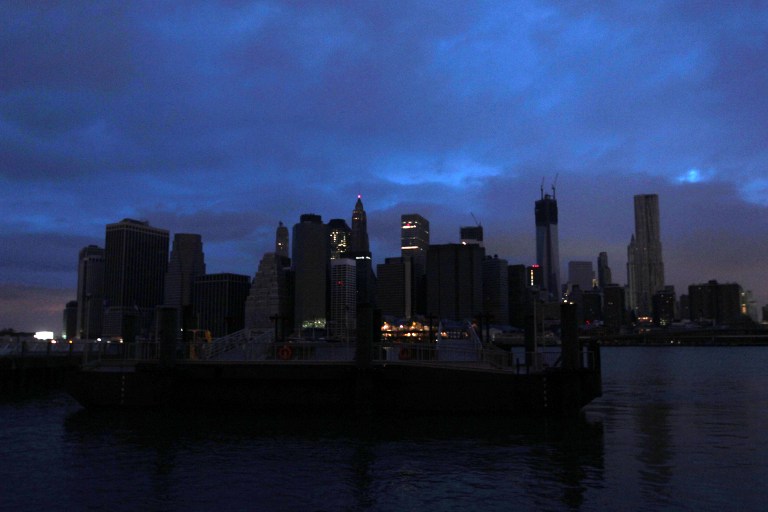SUMMARY
This is AI generated summarization, which may have errors. For context, always refer to the full article.

NEW YORK, USA – New Yorkers struggled to restore power and clear debris Wednesday, October 31, after superstorm Sandy carved a path of destruction from the Caribbean to Canada that left at least 110 people dead.
The massive cyclone that drove hurricane-force winds and deadly ocean surges against a large swathe of the US East Coast was still generating blizzards in the Appalachians, as millions remained without power and transport was snarled.
Less than a week before Americans go to the polls, President Barack Obama planned to tour flooded areas alongside New Jersey Governor Chris Christie, a backer of his Republican rival Mitt Romney.
Romney was meanwhile set to return to the campaign trail in Florida after canceling events Monday and Tuesday to focus on rescue and recovery work, with the race still too close to call as a storm-imposed truce gradually unraveled.
The death toll from accidents related to the storm rose to 43 in North America since Sandy made landfall on Monday, with 67 killed earlier as the then-hurricane tore through the Caribbean.
Meanwhile, authorities and citizens in America’s biggest city struggled to restore vital services and clear debris after a wall of storm-driven seawater swamped road and rail tunnels and triggered massive fires.
“Restoring power and mass transit remain the two biggest challenges in the days ahead,” New York City Mayor Michael Bloomberg told reporters, as rescue crews and utility workers surveyed an apocalyptic scene.
“This is the end of the downside, and hopefully from here it is going up,” Bloomberg said.
In the ocean-front Queens neighborhood of Breezy Point, more than 80 houses burned after flooding caused a fire, while lower Manhattan — New York’s iconic high-rise financial center — was blacked out by a massive power cut.
The New York subway system, much of which was flooded by seawater, was still gripped by what management dubbed its worst disaster in its 108-year history.
Obama, who faces a tough re-election battle on November 6, sent his support.
“America is with you. We are standing behind you and we are going to do everything we can to help you get back on your feet,” he said.
The president said he would tour New Jersey on Wednesday after Christie, the state’s Republican governor, reported “unthinkable” devastation in submerged coastal communities.
Daylight brought surreal images of the storm’s devastation: a boat washed onto a railway track in New York state, cars bobbing like corks in submerged New York City parking lots, and a neighborhood in Queens burnt to cinders.
More than eight million homes and businesses from the Carolinas to Maine were without power Tuesday, the Department of Energy said, with outages increasing as the still-formidable storm moves west towards the Great Lakes.
‘Unthinkable’ devastation
Three US nuclear power reactors remained shut and a fourth on alert, after storm waters wreaked havoc with transmission networks and cooling systems.
Despite worries that water could overwhelm the reactors, as had happened in Japan’s Fukushima nuclear disaster last year, authorities insisted there were no risks to the public.
Insured losses from the massive superstorm Sandy could run between seven and 15 billion dollars (5.4 to 11.5 billion euros), according to initial industry estimates.
Inland, Sandy dumped three feet (90 centimeters) of snow on high ground in Appalachian states as she headed west and north, spreading blizzard conditions over parts of Ohio, Pennsylvania, and West Virginia.
New Yorker Sharon Romano recalled how she had been sitting in the front room of her house when storm waters flooded seafront areas of the city and a nearby power station exploded, plunging much of Manhattan into darkness.
Romano went out onto 14th Street and all she could see was water from the East River: “It was just like a beach with no sand.”
Elsewhere in New York, in the oceanside community of Breezy Point, residents sifted through the rubble after a massive fire somehow destroyed more than 80 homes in an area that had flooded during the storm.
Carol Anderson, 53, whose nearby house escaped the fire but not the flooding, had trouble identifying where streets had been as she picked her way over charred beams and under scorched, dangling telephone and electrical lines.
“What a disaster. It’s like a warzone,” she said.
The New York Stock Exchange and the Nasdaq were shut for their first weather-related closures since Hurricane Gloria in 1985, but both aimed to reopen on Wednesday morning.
The destruction was not limited to New York. Cities up and down the Eastern Seaboard from Boston to Philadelphia to Washington were buffeted by storm-force winds and coastal communities suffered widespread flooding.
Forecasters warned that flooding would continue along the densely-populated mid-Atlantic coast and 7,400 National Guardsmen remained mobilized in 11 states to provide emergency relief.
Obama strove to display leadership in the face of the storm in a bid to avoid repeating the mistakes of predecessor George W. Bush, whose bungled response to Hurricane Katrina in 2005 tainted his presidency.
“Do not figure out why we can’t do something. I want you to figure out how we do something,” he told government officials during a surprise visit Tuesday to the American Red Cross in Washington.
“I want you to cut through red tape. I want you to cut through bureaucracy. There’s no excuse for inaction at this point.” – Sara Hussein and Brigitte Dusseau, Agence France-Presse
Add a comment
How does this make you feel?
There are no comments yet. Add your comment to start the conversation.